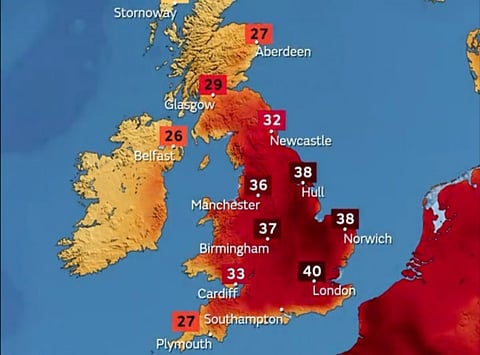Climate Change Scare: The First Red Extreme Heat Warning Issued in UK
For the first time temperatures of 40°C have been forecast in the UK and the Met Office has issued the first ever Red warning for exceptional heat. In Portugal and Spain temperatures have reached highs up to around 46 degrees Celsius.
Exceptional heat is expected to affect a large part of England early this week, with temperatures likely in the high 30s C in some places and perhaps even reaching 40°C, the World Meteorological Organisation (WMO) reported.
The Red Extreme heat national severe weather warning will cover Monday and Tuesday (18th and 19th July) for parts of central, northern, eastern and southeastern England.
Met Office Chief Meteorologist Paul Gundersen, said: “Exceptional, perhaps record-breaking temperatures are likely early next week, quite widely across the red warning area on Monday, and focused a little more east and north on Tuesday.
“Nights are also likely to be exceptionally warm, especially in urban areas. This is likely to lead to widespread impacts on people and infrastructure. Therefore, it is important people plan for the heat and consider changing their routines. This level of heat can have adverse health effects.”
Will we get record-breaking heat?
This is the first time we have forecast 40°C in the UK. The current record high temperature in the UK is 38.7°C, which was reached at Cambridge Botanic Garden on 25 July in 2019.
Some models are now producing a 50% chance of maximum temperatures in excess of 40°C in isolated parts of the UK for the start of next week. Mid, to high, 30s Celsius will be seen more widely with an 80% chance we will exceed the current record.
Is this due to climate change?
“We hoped we wouldn’t get to this situation but for the first time ever we are forecasting greater than 40°C in the UK," climate attribution scientist at the Met Office, Dr Nikos Christidis, said.
“Climate change has already influenced the likelihood of temperature extremes in the UK. The chances of seeing 40°C days in the UK could be as much as 10 times more likely in the current climate than under a natural climate unaffected by human influence."
Whilst a 1°C background temperature increase may not seem significant, the resulting increase in the severity of extreme heat events is already evident in the observed record. This has widespread and significant impacts.
Heatwave hitting all Western Europe
Extreme heat has already spread over Portugal, Spain and France. In Portugal, temperatures have reached highs up to around 46 degrees Celsius. Red warnings are in effect for much of Portugal as hot conditions increase the risk of wildfires.
Wildfires have torn through France in recent weeks, as well as other European countries including Portugal and Spain, and more than 13,000 hectares of land were on fire in the Gironde region in the past five days, up from 7,300 hectares on Friday.
The heatwave in western France is expected to peak on Monday, with temperatures climbing above 40 degrees Celsius.
In neighboring Spain, firefighters were battling a series of blazes on Saturday after days of unusually high temperatures that reached up to 45.7 C (114 F).
The area of high pressure currently over the UK will progressively move east across north-central Europe and reach the Northern Balkans by the middle of next week. This will result in high temperatures for much of western and central Europe
Degradation of air quality
“It is worth pointing that high temperatures is not the only adverse consequence of heat waves," says Lorenzo Labrador, Scientific Officer at WMO’s Global Atmosphere Watch Programme.
“The stable and stagnant atmosphere acts as a lid to trap atmospheric pollutants, including particulate matter, increasing their concentrations closer to the surface. This results in a degradation of air quality and adverse health effects, particularly to vulnerable people."
"Likewise, the abundant sunshine, high concentrations of certain atmospheric pollutants and stable atmosphere is conducive to episodes of ozone formation near the surface, which has detrimental effects on people and plants.”
Understanding the causes
"Every heatwave occurring in Europe today is made more likely and more intense by human-induced climate change," said a study published by scientists at World Weather Attribution on the Human contribution to record-breaking June 2019 heatwave in France.
According to IPCC the frequency of certain types of weather and climate extremes is increasing due to climate change and several attribution studies have shown that it has made many single recent events more intense.
"Although exact connections remain open to scientific discussion, there is growing evidence that some aspects of physical atmospheric dynamics related to human-induced Arctic warming, can at times enhance conditions associated with persistent disturbances in the polar jet stream," said WMO.


